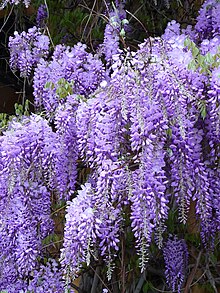Wysteria
| Wisteria | |
|---|---|
 |
|
| Flowering Wisteria sinensis | |
| Scientific classification | |
| Kingdom: | Plantae |
| (unranked): | Angiosperms |
| (unranked): | Eudicots |
| (unranked): | Rosids |
| Order: | Fabales |
| Family: | Fabaceae |
| Subfamily: | Faboideae |
| (unranked): | Inverted repeat-lacking clade (incertae sedis) |
| Tribe: | Millettieae |
| Genus: |
Wisteria Nutt. |
| Species | |
|
See text. |
|
| Synonyms | |
|
|
See text.
Wisteria (also spelled Wistaria or Wysteria) is a genus of flowering plants in the legume family, Fabaceae (Leguminosae), that includes ten species of woody climbing vines native to the Eastern United States and to China, Korea, and Japan. Some species are popular ornamental plants. An aquatic flowering plant with the common name wisteria or 'water wisteria' is in fact Hygrophila difformis, in the family Acanthaceae.
The botanist Thomas Nuttall said he named the genus Wisteria in memory of Dr. Caspar Wistar (1761–1818). Questioned about the spelling later, Nuttall said it was for "euphony," but his biographer speculated that it may have something to do with Nuttall's friend Charles Jones Wister, Sr., of Grumblethorpe, the grandson of the merchant John Wister. (Some Philadelphia sources state that the plant is named after Wister.) As the spelling is apparently deliberate, there is no justification for changing the genus name under the International Code of Botanical Nomenclature. However, some spell the plant's common name "wistaria", and Fowler is decisively for the "wistaria" spelling.
Genetic analysis shows Callerya, Afgekia and Wisteria to be each other's closest relatives and quite distinct from other members of the tribe Millettieae. Both have eight chromosomes.
The following is a list of accepted Wisteria species:
...
Wikipedia
